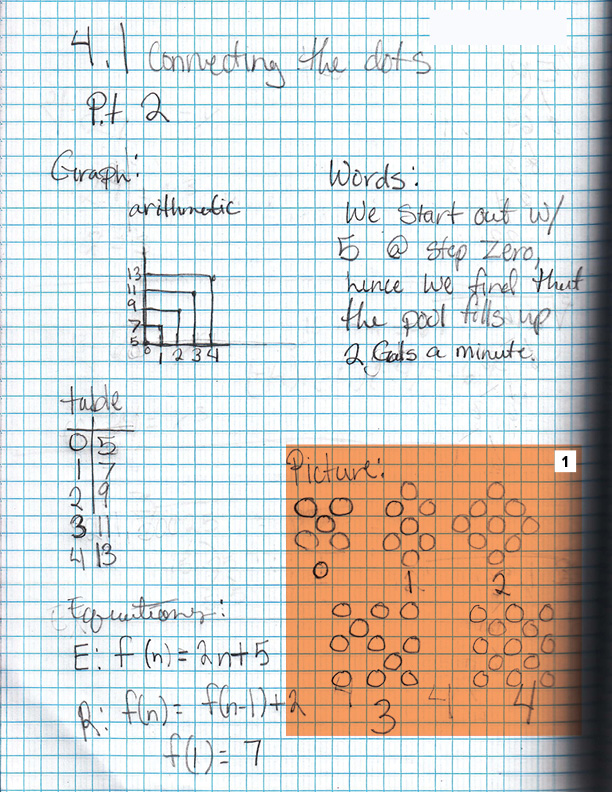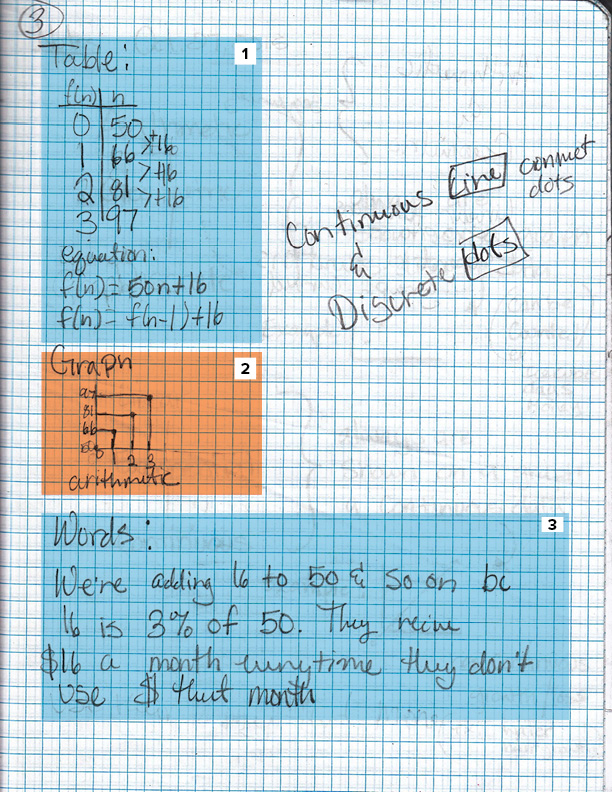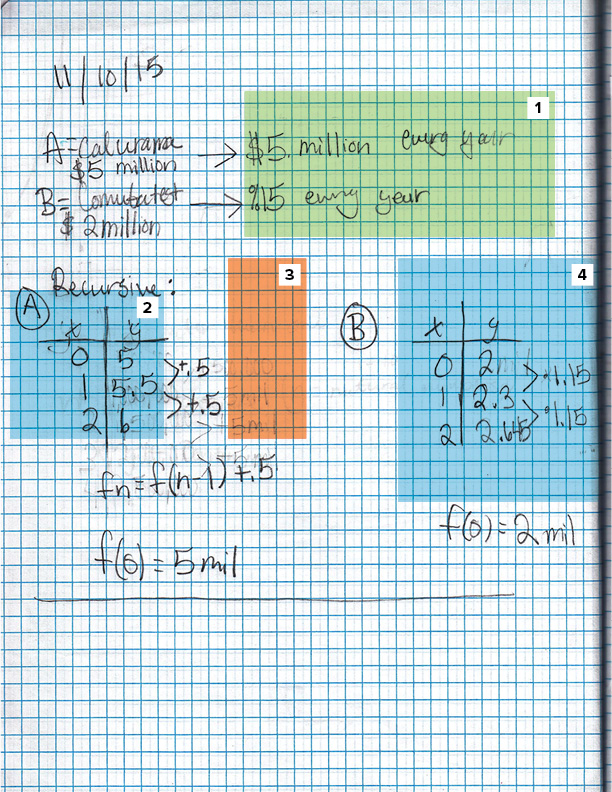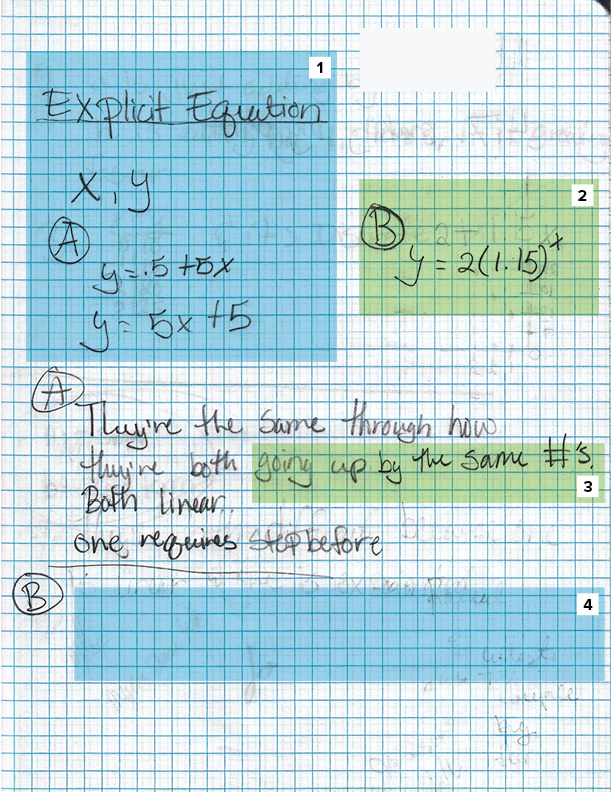All students should graduate from high school ready for college, careers, and citizenship.


NOTE:
This sample of student work was selected from a special education classroom.
1. Comprehension & Application
SMP.7: Look for and make use of structure.
Although the student has seen some well-structured diagrams in previous modules, the student is struggling to create a visual picture to model this situation, since the picture does not show the constant starting amount and the constant rate of growth in a meaningful way. The student can, however, use a discrete linear table to represent the rate of change and the starting amount from a context.

1. CCSS Alignment
The student is not demonstrating proficiency in HSF-LE.A.2. The student can construct recursive equations for linear tables. However, the student is not consistent in writing a correct explicit linear equation from a linear table and graph, as shown in question 3. Although the student incorrectly decides that question 3 is a linear situation, the student does not write a correct explicit linear equation to match the table. Because the student incorrectly identifies the situation in question 3 as linear, there is no evidence that the student can write an exponential equation.
Standard referenced:
HSF-LE.A.2: Construct linear and exponential functions, including arithmetic and geometric sequences, given a graph, a description of a relationship, or two input-output pairs (include reading these from a table).
2. Comprehension & Application
SMP.7: Look for and make use of structure.
In the two linear graphs in question 1 and 3, it appears that all linear graphs pass through the origin, since the student labels the y-coordinate of the origin with the value of the starting amount. This is problematic in distinguishing linear situations that are proportional to linear situations that are not proportional. The student uses the graph to show the mapping between the input and output values of the function, relating the structure of the graph to the structure of the table.
3. CCSS Alignment
The student is below proficient in HSF-LE.A.1. The student is unable to distinguish between linear and exponential contexts.
Standard referenced:
HSF-LE.A.1: Distinguish between situations that can be modeled with linear functions and with exponential functions.

Language Challenges
(Entire page)
Because this is a special education student, when the work is compared to task 1, it appears that number size is obscuring the student’s ability to demonstrate proficiency in explicit and recursive equations. There is evidence of this by the erased notations and revisions in the linear table, and the erased explicit equation for the exponential function.
1. Understanding
There is a mathematical language issue with notation for dollars and percent. The percent sign seems to be used as a unit. the same way the dollar sign is used as a unit.
2. CCSS Alignment
The table gives evidence that the student understands the meaning of the parameter in the context.
Standard referenced:
HSF-LE.B.5: Interpret the parameters in a linear or exponential function in terms of a context.
3. Comprehension & Application
SMP.7: Look for and make use of structure.
As is evident from the number of erasures and revisions in the student work, the student seems to be working back and forth between the tables and the equations, trying to make the structure revealed by the table to match the structure of the equations.
4. CCSS Alignment
The student is approaching proficiency in HSF-LE.A.1c. The student recognizes the number 1.15 as a factor, and can create a table from a percent change, but initially struggled to create the corresponding equation. The equation was revised to the correct form.
Standard referenced:
HSF-LE.A.1c: Recognize situations in which a quantity grows or decays by a constant percent rate per unit interval relative to another.

Understanding
(Enitre page)
The student has shown progress in creating linear and exponential equations when compared to task 4.1.
1. CCSS Alignment
The student is approaching proficiency in HSF-LE.A.2. There is evidence that the student is able to create a recursive linear equation from a context. The student is struggling with the explicit linear equation, since the student exchanges the rate of growth parameter with the initial value. The student has no evidence of the exponential recursive equation but does have the explicit exponential equation.
Standard referenced:
HSF-LE.A.2: Construct linear and exponential functions, including arithmetic and geometric sequences, given a graph, a description of a relationship, or two input-output pairs (include reading these from a table).
2. Understanding
This task is the fifth in the unit and students have encountered percent growth factors before (i.e. Task 4.1). The student is still grappling with this idea. It is unclear what led to the change in the explicit exponential equation.
3. Understanding
The language “going up by the same number” is not precise enough to distinguish between linear and exponential.
4. CCSS Alignment
There is no evidence for standard HSF-LE.A.3 in the work since the student didn’t discuss why Computafest’s plan is better.
Standard referenced:
HSF-LE.A.3: Observe using graphs and tables that a quantity increasing exponentially eventually exceeds a quantity increasing linearly, quadratically, or (more generally) as a polynomial function.
